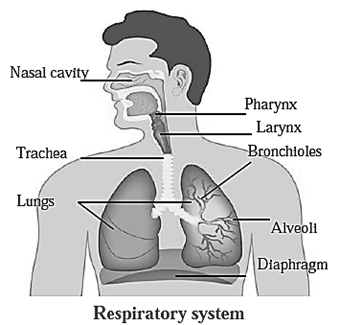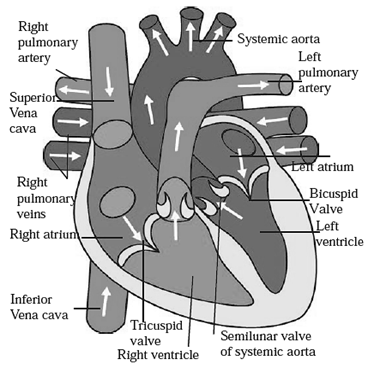Human Body and Organ System
Maharashtra Board Class 8- General Science - Chapter-11
Solution
Question 1:
Find out my partner.
| Group 'A' | Group 'B' |
| 1. Heart beats | a. 350 ml |
| 2. RBC | b. 7.4 |
| 3 WBC | c. 37∘C |
| 4 Blood donation | d. 72 |
| 5 Normal body Temperature | e. 50-60 lakh/mm3 |
| 6 pH of oxygenated blood | f. 5000-6000 per mm3 |
Group 'A'
Group 'B'
1. Heart beats
72
2. RBC
50-60 lakh/mm3
3 WBC
5000-6000 per mm3
4 Blood donation
350 ml
5 Normal body Temperature
37∘C
6 pH of oxygenated blood
7.4
Question 2:
Complete the following table.
| Organ system | Organs | Functions |
| 1. Respiratory | ||
| 2. Circulatory system |
Organ system
Organs
Functions
1. Respiratory
Nose
Traps dust particles and microbes and prevents their entry in the respiratory system.
Pharynx
Acts as a passage for the entry of air into the wind pipe.
Wind pipe
Acts as a passage through which air passes into the lungs.
Lungs
Exchange of gases occurs in lungs.
Diaphragm
By contractions and relaxation it makes breathing movements possible.
2. Circulatory system
Heart
The main organ from where circulation of blood to different body parts occurs.
Arteries
Carry blood away from heart to all the parts of the body. Except for pulmonary artery, all other arteries carry oxygenated blood to supply oxygen to each and every cell.
Veins
Carry blood to the heart. Except for pulmonary veins all other veins carry deoxygenated blood from all the body cells to the heart.
Blood Capillaries
Each important vital organ is provided with capillary network. Exchange of oxygen, nutrients, hormones, vitamins, etc. takes place through the capillary wall.
Plasma
Many proteins present in the plasma which carry out definite functions. Plasma also gives fluidity to the blood.
Question 3:
Draw neat and labeled diagrams.
1. Respiratory system
Respiratory system

2. Internal structure of heart.
Internal structure of heart

Question 4:
Explain with reasons.
a. Human blood is red colured.
Human blood is red in colour due to the presence of the respiratory pigment haemoglobin. Haemoglobin is a red coloured conjugated protein with iron that is present on the red blood cells. Thus imparts red colour to the blood.
b. Upward and downward movement of diaphragm occurs consecutively.
Diaphragm is a muscular partition which is present between the thoracic cavity and abdominal cavity. During the process of breathing, the upward and downward movement of diaphragm occurs simultaneously. The rib muscles also help in these movements.
c. Blood donation is considered to be superior of all donations.
Blood donation is considered superior of all donations because Blood cannot be manufactured by any artificial chemical process. The only way to obtain blood is by donations of blood from a live donor. Blood is needed at times of emergency, it can save someone's life. Most of the lives are lost due to blood loss during surgeries, accidents or cases where regular blood transfusion is required. These lives can be saved, if adequate amount of blood is available.
d. Person with 'O' blood group is considered as 'universal donor'
Person with 'O' blood group does not have any antigen on his/her RBCs. The ‘O’ type blood thus cannot cause clotting reactions in the body of the recipients. Such persons with ‘O’ blood group can donate blood to any person having any blood group therefore they are considered as ‘universal donor’.
e. Food must have limited amount of salts. Food must have limited amount of salts as we require limited amounts of these in our body. Excessive salts in food can cause rise in blood pressure. Such condition is called hypertension. This condition can be dangerous and fatal in some cases. Therefore, one must keep control over sodium content of the food.
Question 5:
Answer the following questions in your own words.
1. Explain the functional correlation of circulatory system with respiratory, digestive and excretory system.
Three systems viz. respiratory, digestive and circulatory always work in coordination.
2. Explain the structure and function of human blood.
Blood is a fluid connective tissue that flows in blood vessels. It is composed of two components- plasma and blood cells. Plasma is a yellowish colour fluid, made up of water (~90%) and some dissolved nutrients, proteins, hormones and waste products. Blood Cells consists of three types of blood cells. These are Functions of blood:
3. Explain the importance and need of blood donation. Blood donation is one of the biggest donations of an individual towards their society. Blood loss can occur under circumstances of accidents, during surgeries or in case of diseases which require blood transfusion. Adequate amount of available blood can save many lives. It does not harm or effect the body of the donor and the amount of blood which is donated is recovered within 24 hrs.
This donated blood can be stored and used as and when the requirement arises.
Question 6:
Explain the differences.
1. Arteries and veins.
External respiration
Internal respiration
1. It occurs between the body and external environment.
It occurs at the cellular level.
2. It is a mechanical process.
It is a chemical process.
3. It can be both- voluntary and involuntary action.
It is only an involuntary action.
4. External respiration involves breathing and gaseous exchange.
Internal respiration involves neither breathing nor gaseous exchange.
5. Oxygen combines with haemoglobin in external respiration.
Chemical reactions occur in the cells to form energy.
2. External and internal respiration
Arteries
Veins
1. Carries blood towards organs and away from heart.
Carries blood towards heart and away from organs.
2. Carries fully oxygenated blood
Carries deoxygenated and CO2 enriched blood.
3. Blood flows with high pressure and jerks,.
Blood flows with low pressure and smoothly.
4. Have no valves
Have valves to prevent backflow of blood.
5. Walls are elastic.
Walls are non-elastic.
6. Are Deeply placed.
Are superficial.
7 Branched and decreases in size.
Unites and increases in size
8. Can constrict and dilate
Cannot constrict.
9. Have thick and muscular walls
Have thin and less muscular walls.
10. Smallest artery is called arteriole
Smallest vein is called Venules.
Question 7:
Which health parameters of blood donor should be checked? The following parameters of blood donors have to be checked prior blood donation:
Question 8:
Fill in the blanks using appropriant words given in the bracket.
( hemoglobin, alkaline, diaphragm, red bone marrow, acidic, voluntary, involuntary.)
i. RBCs of the blood contain _________, an iron compound.
ii. ____________ is present between thoracic and abdominal cavity.
iii. Cardiac muscles are_______
iv. pH of oxygenated blood is________
v. Production of RBCs occurs in__________
i. RBCs of the blood containhemoglobin, an iron compound. ii. Diaphragmis present between thoracic and abdominal cavity. iii. Cardiac muscles are involuntary. iv. pH of oxygenated blood is alkaline. v. Production of RBCs occurs in red bone marrow.
Question 9:
Find odd one out.
1. A, O, K, AB, B.
K is the odd one out because it is an inorganic ion while rest of the four are types of blood groups.
2. Blood plasma, platelets, blood transfusion, blood corpuscles.
Blood transfusion is the odd one out because it is a techniques for transferring of blood. Rest of the three are components of blood.
3. Trachea, alveoli, diaphragm, capillaries.
Capillaries are the odd one out because it exists throughout the body, while rest of all are the parts of the respiratory system.
4. Neutrophils, globulins, albumins, prothrombin.
Neutrophils are the odd one out because they are a type of blood cell. Rest of the three are proteins present in the plasma.
Read the following paragraph and identify the disease.
Today, her child became one and half year old. However, that child does not seem to be healthy and happy. It was continuously crying and gradually becoming weak. It has shortness of breath. Its nails have become blue.
From the above mentioned symptoms, it seems like the child is suffering from some kind of respiratory disorder/circulatory disorder. He has problem in breathing and his nails have become blue which means there is low level or lack of oxygen circulating in the red blood cells, thus the baby may be suffering also from respiratory problems.
Question 11:
Your neighboring uncle has been diagnosed with hypertension. what should he do to keep his blood pressure within normal range?
Hypertension has many causes. Try to find out what is the exact cause. Is it lack of exercise, obesity, lots of fast and junk food consumption, over-intake of salt, mental tension, etc? The following methods can be adopted to keep the blood pressure within normal range: regular monitoring of blood pressure
Useful links :
| Main Page : - Maharashtra Board Class 8th General Science - All chapters notes, solutions, videos, test, pdf.
Books : MSBSHSE -Class 8th Science Text Books – Chapter wise PDF for download Videos : Maharashtra Board Class 8th General Science Videos - watch chapter wise topic wise videos of all chapters Previous Chapter : Chapter 10- Cell and Cell Organelles - online Solution Next Chapter : Chapter 12- Introduction to Acid and Base -online Solution |